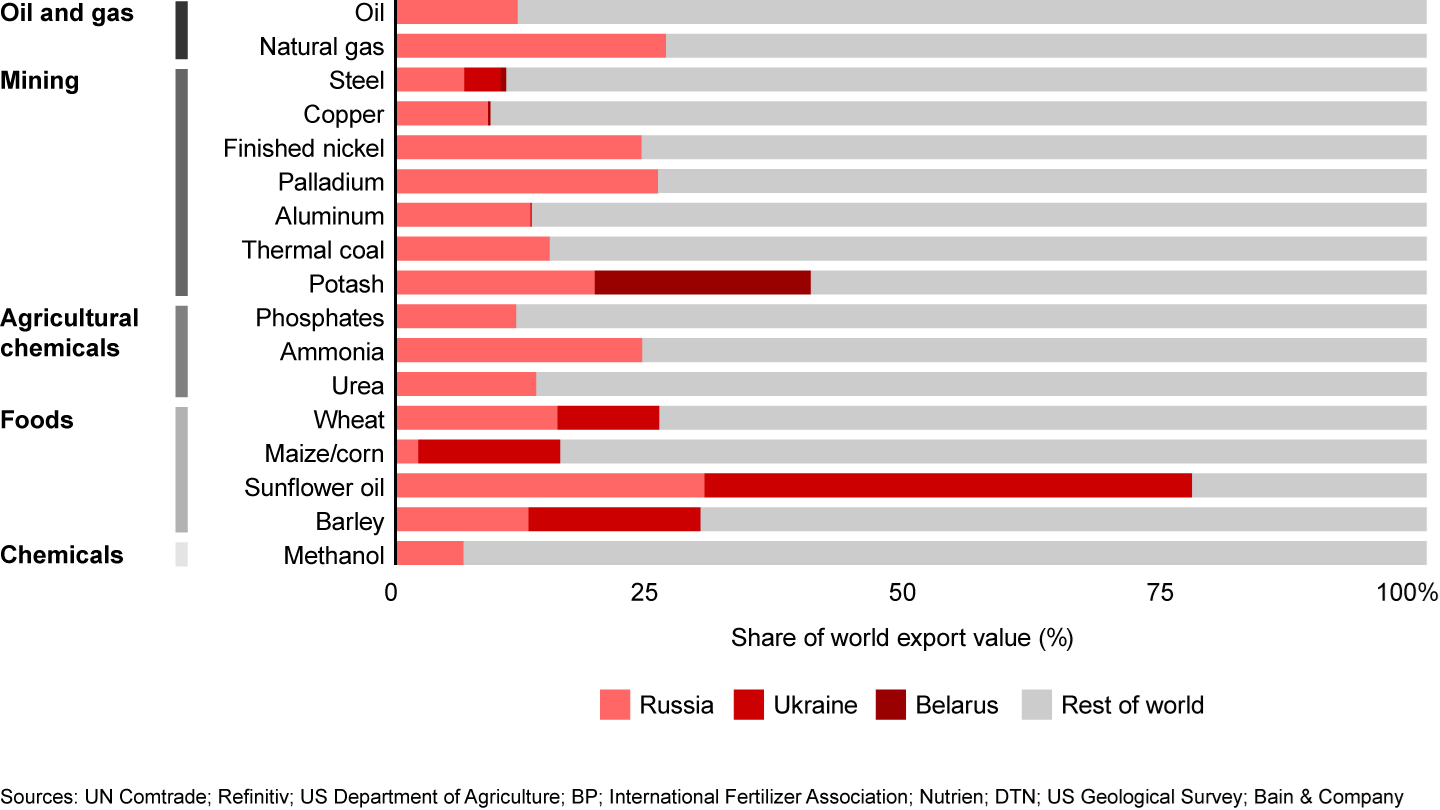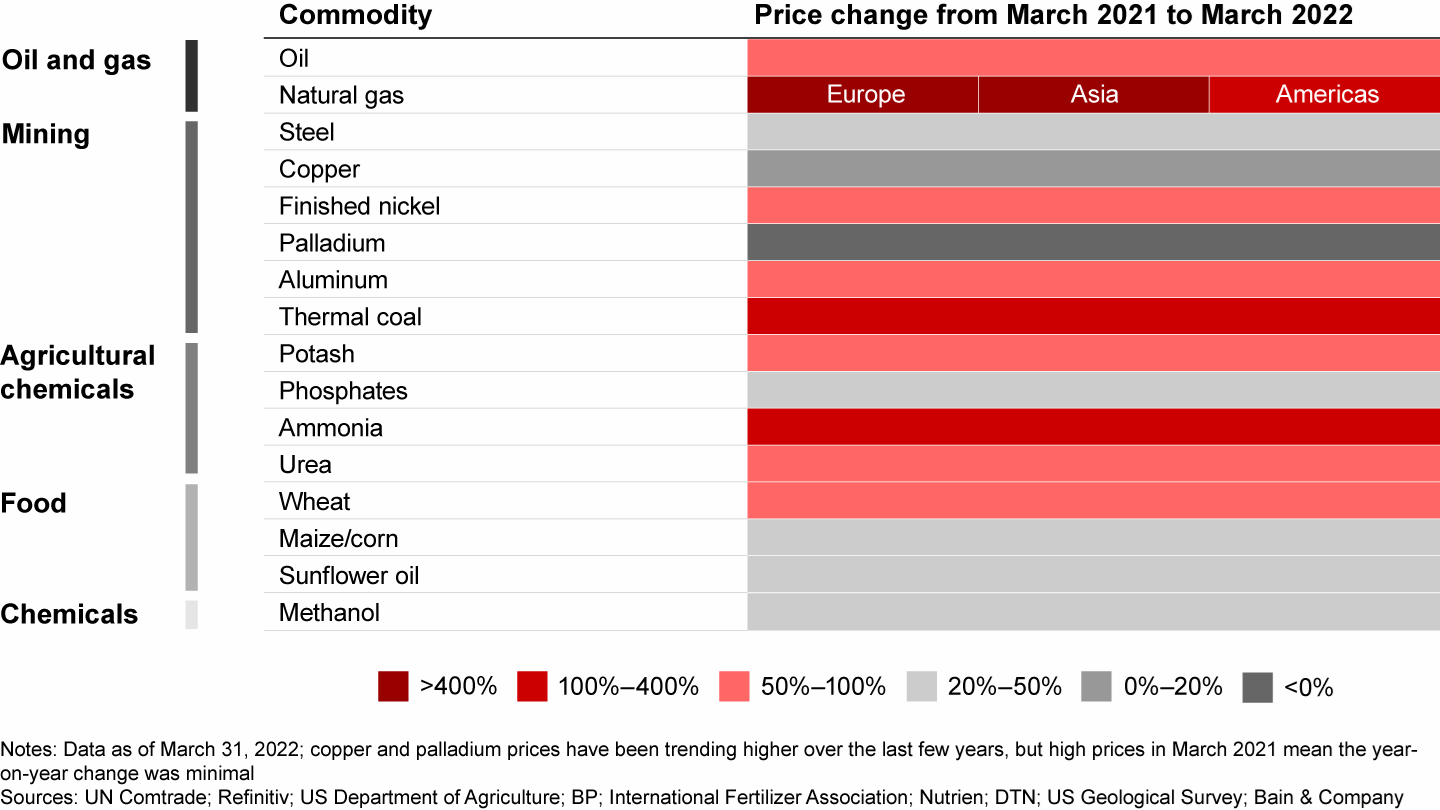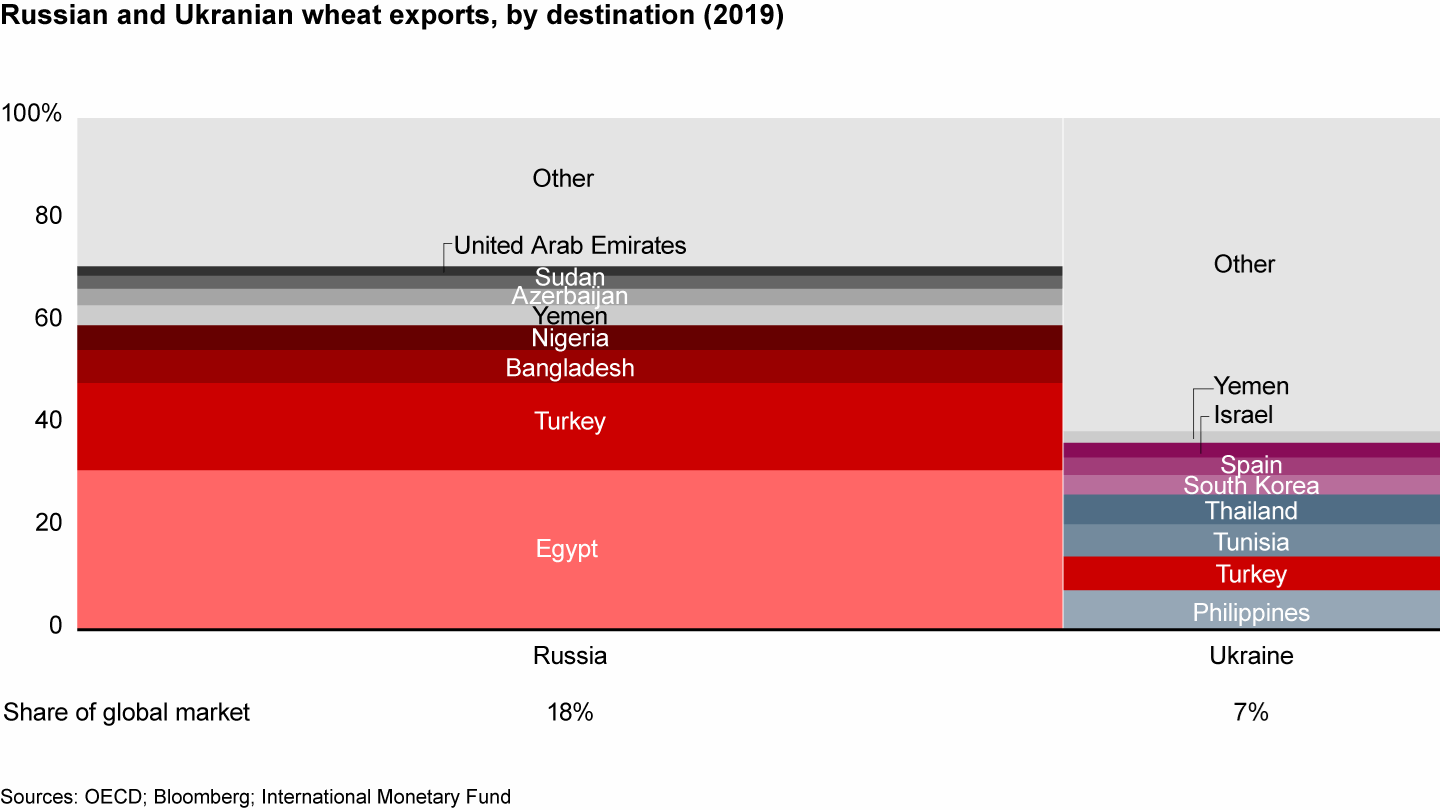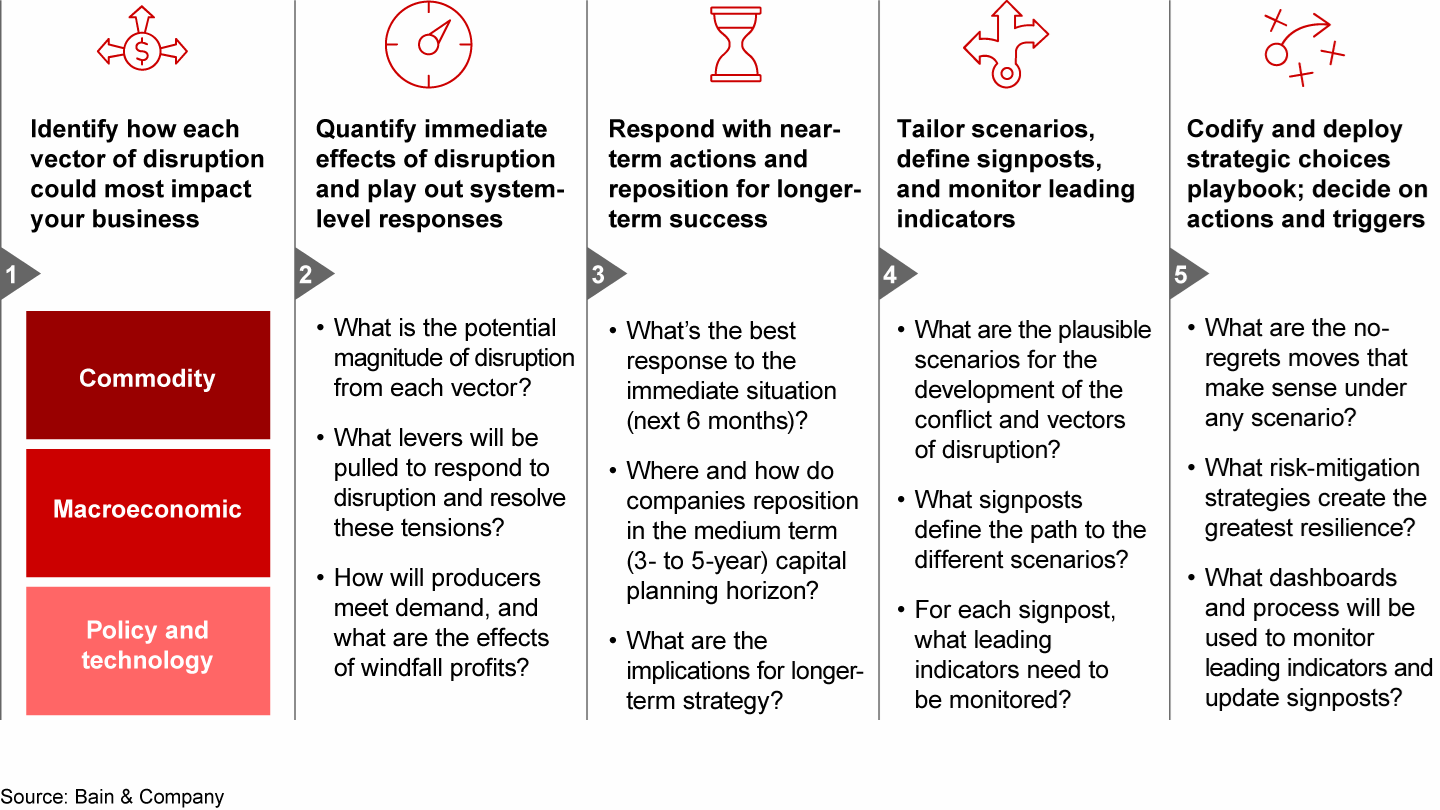Brief

Резюме
- As the war in Ukraine continues, energy and natural resource companies are moving past their initial shock and beginning to integrate new economic realities into their planning.
- Resilience can be expensive, so executives need to determine where it makes the most sense to invest.
- Identifying disruptions at three levels—commodity, macroeconomic, and policy—helps companies see where and how their businesses will be affected.
- By tailoring scenarios of plausible outcomes and following the vectors of disruptions, companies can prepare themselves for a range of possible outcomes.
As the war in Ukraine continues in its second month, companies and their leadership teams are beginning to move past their initial reactions of shock in order to integrate the crisis into their medium- and long-term planning. The war is an unfolding tragedy, but also—when viewed through the lens of corporate strategy—an extreme example in a string of global disruptions that seem to be coming faster, more frequently, and with greater intensity than they once did.
For most companies, a critical component of their response to the crisis is finding ways to make their businesses, operations, and supply chains more resilient. It’s becoming increasingly prudent to prioritize resilience over low cost or efficiency. “Just in time” has been replaced by “just in case.”
Resilience is critical, but resilience is also expensive. For longer-term survival, companies still need to pay attention to the basic principles of leadership: innovation, impact, and economics. But as they recover from the initial shock and begin to make longer-term plans, companies need to answer the question: Where is resilience worth the cost?
The answers differ for each company. Getting it right requires at least two things. First, companies need to develop a comprehensive understanding of their vulnerabilities to a range of disruptions, including risks to people, business continuity, asset economics, and financial performance. In some cases, these risks may originate two or three steps away from their typical planning view. For most companies in the energy and natural resource sectors, the immediate response requires understanding the supply-side shocks affecting the commodities for which Russia, Ukraine, and Belarus play a key role in production and trade (see Figure 1). These supply challenges could restructure trade flows while also invigorating domestic alternatives.
Percentage of global commodities produced by Russia, Belarus, and Ukraine


The second step aims at longer-term insights and better decision making. Questions like, “Where is resilience worth the cost?” and, “Should I respond to today’s shortage with a major new capital investment?” are best considered in the context of scenarios that reflect a set of plausible outcomes. By developing a set of tailored scenarios specifically anchored on those potential disruptions and their associated uncertainty, companies lay the groundwork for repositioning their organizations to thrive in a rapidly shifting business environment.
Scenario planning
Companies can map out potential impacts using scenario planning to aggregate different trajectories of the business environment. For example, a rapid return to globalized trade would be characterized by short-term disruption to commodities, modest macroeconomic effects, and a renewed emphasis on environmental, social, and corporate governance (ESG) considerations. Although similar to conditions a year ago, this scenario would still be more cautious than before Russia invaded Ukraine, recognizing resource security as a priority.
In another scenario, the world is changing, and the invasion would be the latest manifestation of that change, marking an end to the efficient trade of a globalized world, and the beginning of a world fractured into nearly independent trade blocs. In this scenario, loss of efficiency drives up commodity prices. Trade blocs would focus on security of supply, creating redundancy and increasing global demand. Supply chains and global trade would be severely disrupted, but growth possible. Companies would find that sanctions and national interests govern their operations more than in the past.
Companies in the energy and natural resource sectors will feel the disruption of these scenarios at three different levels.
- Commodity level, affecting the local and global market conditions specific to each commodity and market (for example, European gas demand, global wheat pricing).
- Macroeconomic level, reflecting how commodity disruptions can affect the broader economy, including inflationary pressure or recession risk.
- Policy and technology implications, including the speed of technology development and the role of government spending.
Commodity shortages and resulting price spikes will flow to downstream customers for whom these are key inputs (including manufacturing, power generation, fertilizers, and many others). Because some of these commodities (notably oil, gas, and food) are among the broadest inputs into the overall economy, all consumers will pay higher prices for consumer goods. The pressure on household budgets will drive government responses in the form of subsidies, tax relief, and other measures, to try to ease the burden on the general public, and those regulatory responses will feed back into the dynamics that companies face as they decide how to navigate this set of disruptions.
Companies have been responding in real time and planning how to optimize their infrastructure and relationships for the near term. Now, for many, the planning cycle introduces an opportunity to explore how the conflict will alter near- and long-term decisions, especially influencing both the capital cycle and portfolio views. Over the next weeks and months, it will be critical for companies to reexamine recent events through the lens of risk and opportunity. Some CEOs may determine that increasingly volatile business environments merit a premium for resilience, while others may look for ways to pursue efficiency to undercut competitors when markets are favorable.
Commodity level
In the face of these disruptions, primary commodity producers will look to increase capacity to displace Russian exports, customers and finished-product companies will have to absorb price shocks and supply constraints, and midstream traders will need to forge new connections as markets react and evolve (see Figure 2). Some business customers are already experiencing shortages.
Prices have risen dramatically for many commodities that are major exports of Russia and Ukraine


Markets will respond to the threat of commodity supply interruptions in four ways.
- New sources of supply will replace those affected by sanctions or shifting trade routes. For example, European countries are making new agreements with Qatar and the US for liquefied natural gas (LNG) to replace piped gas from Russia.
- Substitute goods provide alternatives. When Russian sunflower oil fell under sanctions, prices for Malaysian palm oil surged.
- Reduced demand, whether resulting from high prices (as with some ammonia producers in Eastern Europe) or coordinated demand responses (such as the IEA’s call to set thermostats 1oC lower, to consume less gas).
- Rerouting trade routes in response to sanctions and to supply emerging trade blocs. For example, Russia and India are negotiating for delivery of discounted oil shipments rejected by European markets.
For each commodity, these changes carry risks, but also create new opportunities that companies will need to navigate in an uncertain and rapidly evolving market environment. We’ll consider three fundamental inputs to the economy: gas, oil, and wheat.
Natural gas. Europe depends on Russia for 60% of its imported natural gas, and its imports consume 75% of Russia’s exported gas volume. The European Union has reacted quickly with proposals that could cut that dependence in half relatively quickly, even in a cautious scenario, reflecting Europe’s newfound concerns for energy security. The proposals rely heavily on bringing in alternative supplies in the form of international LNG, and more European purchases of LNG on the spot market will raise demand and prices beyond usual patterns.
Substitution is possible in the near term by prolonging the life of nuclear plants that had been scheduled to shut down, and accelerating the queue of wind and solar projects (though these renewable sources remain intermittent without at-scale power storage, so they aren’t perfect substitutes). These substitutes can introduce power to the grid to offset demand for gas.
Demand reduction is also in scope. Higher prices will reduce demand for natural gas. These high costs will present stiff challenges for gas-intensive European industries and provide opportunities for low-cost manufacturers, especially those that have cheaper gas and can export to European markets.
Additional offsetting will be painful. In more extreme scenarios, this could mean not just higher costs, but also the risk of backsliding on environmental goals. Swapping coal or oil for gas could reduce dependence on Russian gas supplies, but at the cost of increasing carbon emissions.
Even with these more painful measures, Europe can’t easily reduce its dependence on Russian gas by much more than 60%, meaning continued dependence on some 50 billion to 70 billion cubic meters (bcm) of Russian gas per year. This is a harsh prospect for the winter of 2022–23, and the potential threat to this critical energy source has left already tight markets on edge, manifest as increased volatility and a premium for secure supply. Because Russia's government is disproportionately funded by oil and gas, which together comprise only 7% of Russian GDP, but about 40% of the government’s budget, both parties will want to see gas continue to flow, at least to fulfill existing contracts. It could take at least five years to fundamentally change this relationship, partly because the infrastructure will take that long to build. There’s no viable alternative for Russia to reroute most of its gas exports in the short term; there are only so many wind and solar plants that can be accelerated into 2022, only so much uncontracted LNG available to reroute, and only so much new global liquefaction capacity under construction and set to come online in the next three to four years.
The acute awareness of the importance of energy security clearly affects opportunities and risks for energy players. Gas and LNG suppliers may find good terms for contracting new capital projects. New pipelines that would have encountered public resistance a year ago may find a more hospitable regulatory process. Power rates, buoyed up by gas prices, may help accelerate economics for new renewable power projects. These tailwinds will run up against increased demand for hardware and energy services. In addition to other sources of inflation, this will drive higher costs of labor and materials, all of which will distort historical project economics.
For energy consumers, especially those heavily dependent on gas, project economics will also shift. Companies weighing a potential move toward electrification to reduce their carbon footprint may find the decision easier in a world where gas prices are subject to occasional and prolonged spikes up to five times the usual price. The value of hedging and long-term contracts may be greater going forward. And security of supply doesn’t necessarily translate to domestication of supply lines; expansion into lower-priced energy markets may present new avenues for growth.
Oil. Before the Covid-19 pandemic, Russia supplied 7.8 million barrels a day (mbd) of crude oil and refined products. Today, about two-thirds of Russia’s exported oil flows to countries that have backed sanctions, while the balance flows to countries that have not, including China and some Central and Eastern European countries.
Before the war began, global oil supply was already tightening due to recovering demand as the pandemic waned, boosting prices from around $54 per barrel in January 2021 to $74 in December. Storage levels for crude and refined products were falling, and countries were beginning to release strategic reserves as prices neared $90 per barrel. Much of OPEC+ (although not Saudi Arabia or the United Arab Emirates) had fallen short of its scheduled production increases by about 700,000 bpd. On March 31, members agreed to add 430,000 bpd beginning in May, and some of the shortfall could also be made up by new supply sources.
It’s unlikely that the bulk of Russia’s 7.8 mbd would come offline for any significant period of time. The oil market is global and liquid, with low transportation costs and relatively high destination flexibility, so rerouting of flows is feasible even in the near term.
The global oil market is also porous, with a long history of “sanctioned” oil (from countries like Venezuela and Iran) finding its way to market and exerting influence even if not in the official numbers. Refined products are even easier to reroute than oil, and they make up about 2 mbd to 3 mbd of Russia’s total exports, all of which are likely to find markets.
Given this, in a cautious scenario, up to 1 million barrels of Russia’s daily export volume would be curtailed, an amount that’s relatively easy for the global market to adapt to. Sanctions from the US and European Union may be relatively easy to circumvent, even by lower- and middle-income countries that may be able to buy Russian liquids at a discount.
In a more extreme, fractured scenario, about 3 mbd to 4 mbd could struggle to find a market. This friction and tepid Western demand would curtail production and combine with other sanctions to erode Russia’s oil sector. The loss of access for Western capital, including the withdrawal of major oil and gas companies like BP, Equinor, and Shell, along with suspended business by oilfield service companies Halliburton, Baker Hughes, and Schlumberger, could impede the rollout of capital projects to maintain and expand Russia’s energy infrastructure. As depletion and depreciation take their toll, and as foreign know-how, expertise, and hardware become scarcer in the region, supply could decrease by 3 mbd, even without direct sanctions on the industry.
Wheat. Russia and Ukraine play an important role in the global food chain (see Figure 3). In addition to exporting critical fertilizer ingredients such as ammonia, phosphate, and potash, they together make up about 14% of global wheat production and one-quarter of the global wheat trade. Much of this wheat ships to North Africa and the Middle East. Egypt, for example, is the world’s largest importer of wheat, importing nearly 60% of its wheat consumption, with about 80% of imports coming from Ukraine or Russia. Prices on the types of wheat that Russia and Ukraine export have gone up 40% to 60%, so Egypt and other importing countries will need to pay higher prices for wheat on the global market to feed vulnerable populations—one of many causes for concern.
Wheat farmers in the Southern Hemisphere may be in a position to supplement some of the shortfall, benefiting from higher prices as they do. Shifting production from other crops to wheat could affect the prices of other commodities such as soy, barley, corn, and sunflowers, reducing volumes and raising prices. If the war continues, Northern Hemisphere farmers could face the same decisions in the next planting year, spreading the ripple effects on these commodity crops.
In thinking about whether and how to sanction Russian exports, it’s important to remember that many food and agricultural companies and organizations feed the world as part of their mission. When food companies weigh whether to continue operating in Russia and other countries in the region, they must consider the human cost borne by people uninvolved in the conflict, such as the vulnerable communities in Egypt that rely on Russian and Ukrainian wheat for their (subsidized) daily bread.
Disruption to agricultural trade flows could lead to major challenges in supplying food, especially in the Middle East and North Africa


For sectors depending on these and other commodities, the supply disruptions are sure to cascade down the value chain, creating volatility in price and supply for many products that might not seem to be immediately affected. In some cases, the effect on downstream industries may be dramatic as companies struggle with shortage-driven business-continuity risk and spikes in input costs well beyond anything they’ve planned for. The impacts downstream can also be hard to see when considering just the commodities. For example, palladium shortages could affect the production and costs of catalytic converters, hampering the auto industry. Companies across sectors—not just in energy and natural resources, but also in consumer goods, manufacturing, technology, retail, and logistics—should be running scenarios to prepare for uncertain outcomes.
Macroeconomic factors
In a fractured scenario, persistently high and frequently spiking commodity prices and deepening supply shortages will accelerate the inflation that was already underway before the war began. Consumers are likely to cut back on nonessential spending, depending on their sensitivity and exposure to price increases, and central banks will fall under greater pressure to raise interest rates. Even in a cautious scenario, elevated commodity prices will prevail.
Across all scenarios, financial markets are likely to see even greater volatility as investors react to developments in the war and affected economies. Capital flows to Eastern Europe will diminish, and in a fractured scenario, a liquidity crunch could escalate as investors exercise greater caution and respond to central bank moves.
The combination of reduced consumer spending and deteriorating financial conditions would lead to an economic slowdown or recession in the fractured scenario. This could put governments back in the position of introducing economic stimulus measures, as they did during the Covid-19 pandemic—all while stubbornly high commodity prices could suppress any economic boost that would help consumers cope with recession.
Policy and technology implications
In a fractured scenario, sanctions and trade interruptions would realign geopolitical blocs, with trade and investments blocs decoupling. Europe and the US are already rekindling trade relationships with some regimes that had been out of favor, including Venezuela and Iran, in order to shore up crude oil inventory. In a cautious scenario, global trade resumes, but a premium would remain for domestic or secure supply lines.
Governments are likely to implement more active industrial policies, along with interventions aimed at counteracting the harm from the conflict or to accelerate their response, particularly in nations that rely on resource imports from the conflict region. The European Union’s REPowerEU initiative, for example, aims to speed up and streamline the process for developing renewable energy infrastructure.
In the private sector, investors and consumers are likely to further increase scrutiny on energy and supply chain issues across scenarios. Cybersecurity will receive added attention, especially in a fractured world, and the investments in protection and amelioration will increase.
Windfall profits and the energy transition
The crisis is likely to accelerate the energy transition, as markets race to increase their reliance on renewables as part of a broader strategy to reduce their dependence on Russian hydrocarbons. Green energy will increasingly be associated with localization of energy supply.
The immediate increase in energy prices makes renewables more attractive. For example, green hydrogen may be more competitive in some markets, given higher gas prices. In the near term, however, high prices for some commodities (for example, nickel, palladium, and polysilicon) could blunt demand for renewables and energy storage. There will likely be a growing recognition of the inherent volatility of the energy transition, leading to a recognition that fossil fuels will be needed as bridge fuels (particularly natural gas, and even coal) and a potential renaissance of nuclear energy.
The rise in energy prices will also deliver windfall profits to many fossil fuel energy companies far from the conflict. Executive teams will have to decide whether to reinvest these profits in producing more traditional fuels, invest them in new businesses focused on renewables, or distribute them to shareholders.
At the same time, energy security is likely to be more prominently linked to national security, with calls to redesign global supply chains and diversify away from hostile states. These shifts and the transition from fossil fuels will clearly result in higher prices for consumers, either directly or in the form of taxes, at least over the medium term. It remains an open question how much consumers will be willing to bear, particularly in the context of underlying and accelerating inflation.
Respond and reposition
Responding to an unfolding crisis, ensuring the safety of employees, and protecting the continuity and resilience of operations has been the first order of business for companies affected by the war in Ukraine. The immediate next task must be to reposition organizations to thrive in a changed environment. In approaching this, executives can use the same themes that have guided them through the uncertainty of the past few years.
- Innovation. How can the company adapt and evolve to changed conditions? As with the ongoing energy transition and the Covid-19 pandemic, new technologies and ways of working may be critical assets in setting up new models.
- Impact. How will supply disruptions impact the company’s ESG ambitions? Some emissions-reduction ambitions could see a setback in the immediate rush to substitute energy sources, but could then accelerate as companies and countries invest in renewables to shore up energy security.
- Economics. Identifying where to invest in strengthening resilience is critical in the short and medium term. But long-term viability demands that executives continue to focus on generating value in order to draw the capital and access resources necessary for success.
In the near term, executives can follow a simple, five-step approach for determining how to respond and begin to reposition (see Figure 4).
- Identify how each of the three levels of disruption (commodity, macroeconomic, political and technological) affects your business operations. For example, companies should evaluate how the renewed focus on energy security might affect their own energy transition and how inflation could raise the costs of capital projects.
- Quantify immediate effects of disruption and play out responses for each level of disruption. For example, companies should consider which alternative sources could come online to disrupt any benefits from a potential windfall. Testing the more extreme edge, they must also consider what commodity price would compel them to shut down operations, or when they might need to break contracts to find new vendors.
- Respond with near-term actions and reposition for longer-term success. For example, companies should determine which capital projects in the queue they should accelerate to take advantage of a changed business environment. Companies also need to evaluate supply chain and stranded-asset risks and determine where they should invest in resilience.
- Tailor scenarios and define signposts and leading indicators. Most executives will want to know how quickly they can get their business back to normal. Identifying the right indicators will help them determine whether they’re moving through a cautious or fractured scenario. That will shed light on what changing conditions they need to understand—for example, assessing what would happen if a competitor in China can access low-cost Russian oil while others have to pay more for nonsanctioned crude.
- Codify and deploy a strategic choices playbook. Identify no-regrets moves and risk-mitigation strategies to create more resilience in their operations.
A five-step approach helps develop concrete actions to respond and reposition in the immediate and medium terms


The authors would like to thank Martin DeZell, Aleks Rosnev, and Jordan Friedman for their contributions to this work.